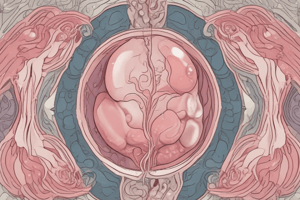Podcast
Questions and Answers
Which of the following is a common disorder treated in gynaecology?
Which of the following is a common disorder treated in gynaecology?
- Asthma
- Endometriosis (correct)
- Hypertension
- Arthritis
What is a primary purpose of routine pelvic exams in gynaecology?
What is a primary purpose of routine pelvic exams in gynaecology?
- Assess bone density
- Detect cervical cancer (correct)
- Check blood pressure
- Screen for diabetes
Which surgical procedure involves the removal of fibroids?
Which surgical procedure involves the removal of fibroids?
- Hysterectomy
- Culdocentesis
- Myomectomy (correct)
- Laparoscopy
Which symptom is commonly associated with menopause?
Which symptom is commonly associated with menopause?
What is a form of contraception that is typically used to prevent pregnancy?
What is a form of contraception that is typically used to prevent pregnancy?
Flashcards are hidden until you start studying
Study Notes
Definition
- Gynaecology: Branch of medicine dealing with the female reproductive system, including the diagnosis and treatment of disorders.
Key Areas of Focus
-
Anatomy of the Female Reproductive System
- Ovaries
- Fallopian tubes
- Uterus
- Vagina
- External genitalia
-
Common Disorders
- Menstrual disorders (e.g., dysmenorrhea, amenorrhea)
- Polycystic ovary syndrome (PCOS)
- Endometriosis
- Uterine fibroids
- Cervical cancer
-
Preventive Care
- Routine pelvic exams
- Pap smears (screening for cervical cancer)
- Breast examinations
- Vaccination (e.g., HPV vaccine)
-
Reproductive Health
- Contraception options (hormonal, barrier, intrauterine devices)
- Infertility management
- Pregnancy complications (e.g., ectopic pregnancy)
-
Surgical Interventions
- Hysterectomy (removal of the uterus)
- Laparoscopy (minimally invasive surgery)
- Myomectomy (removal of fibroids)
-
Menopause
- Symptoms (hot flashes, mood changes)
- Hormone replacement therapy (HRT) options
- Osteoporosis risk
Professional Roles
- Gynaecologists: Medical doctors specializing in gynaecology.
- Nurse practitioners: Provide care and education related to women’s health.
- Midwives: Assist in childbirth and prenatal care.
Diagnostic Tests
- Ultrasound (checking reproductive organs)
- Blood tests (hormone levels, pregnancy tests)
- Colposcopy (examination of the cervix)
Common Treatments
- Medications (hormonal therapies, pain relief)
- Lifestyle changes (diet, exercise)
- Surgical procedures depending on diagnosis
Importance of Gynaecological Health
- Essential for reproductive health and overall well-being.
- Early detection of conditions leads to better outcomes.
- Regular check-ups important for maintaining health.
Female Reproductive System Anatomy
- Ovaries produce eggs and hormones (estrogen and progesterone).
- Fallopian tubes transport eggs from ovaries to uterus.
- Uterus is where a fertilized egg implants and develops.
- Vagina is the birth canal and connects the uterus to the external genitalia.
- External genitalia include the vulva, clitoris, and labia.
Common Gynaecological Disorders
- Menstrual disorders: Dysmenorrhea (painful periods), amenorrhea (absence of periods).
- Polycystic ovary syndrome (PCOS): Hormonal imbalance causing irregular periods, ovarian cysts, and fertility issues.
- Endometriosis: Uterine tissue grows outside the uterus, causing pain and fertility problems.
- Uterine fibroids: Benign tumors in the uterus that can cause heavy bleeding and pain.
- Cervical cancer: Cancer of the cervix, preventable through vaccination and regular screenings.
Preventive Gynaecological Care
- Routine pelvic exams: Visual examination of the external and internal genitalia.
- Pap smears: Detects abnormal cervical cells, crucial for early cervical cancer detection.
- Breast examinations: Self-exams and clinical exams to detect breast abnormalities.
- HPV vaccination: Prevents infection with human papillomavirus (HPV), a major cause of cervical cancer.
Reproductive Health and Gynaecology
- Contraception: Various methods available, including hormonal (pills, patches), barrier (condoms), and intrauterine devices (IUDs).
- Infertility management: Diagnosis and treatment of infertility, including assisted reproductive technologies (ART).
- Pregnancy complications: Ectopic pregnancy (pregnancy outside the uterus), gestational diabetes, preeclampsia.
Gynaecological Surgical Interventions
- Hysterectomy: Surgical removal of the uterus.
- Laparoscopy: Minimally invasive surgical technique using small incisions.
- Myomectomy: Surgical removal of uterine fibroids.
Menopause and Gynaecological Health
- Menopause symptoms: Hot flashes, night sweats, mood changes, vaginal dryness.
- Hormone replacement therapy (HRT): Replaces declining estrogen and progesterone levels.
- Osteoporosis risk: Increased risk of osteoporosis (bone thinning) post-menopause.
Gynaecological Professionals and Diagnostic Tests
- Gynaecologists: Medical doctors specializing in female reproductive health.
- Nurse practitioners: Provide comprehensive women's health care.
- Midwives: Provide prenatal care and assist in childbirth.
- Diagnostic tests: Ultrasound (imaging of reproductive organs), blood tests (hormone levels, pregnancy tests), colposcopy (cervical examination).
Gynaecological Treatments
- Medications: Hormonal therapies, pain relievers, antibiotics.
- Lifestyle changes: Diet, exercise, stress management.
- Surgical procedures: Depending on the diagnosis and severity of the condition.
Importance of Gynaecological Health
- Crucial for reproductive health and overall well-being.
- Early detection and treatment improve outcomes significantly.
- Regular check-ups and preventive measures are vital for maintaining optimal health.
Studying That Suits You
Use AI to generate personalized quizzes and flashcards to suit your learning preferences.




